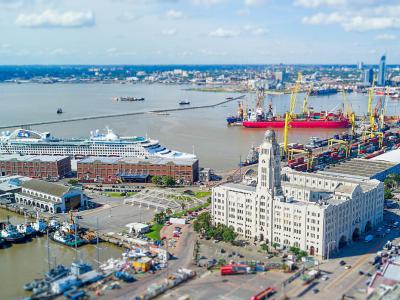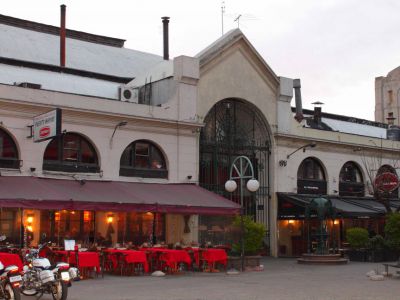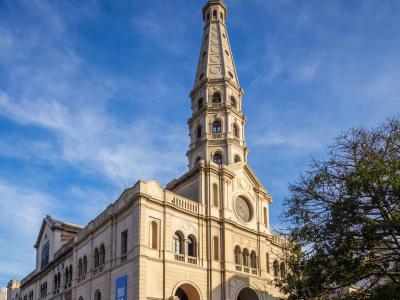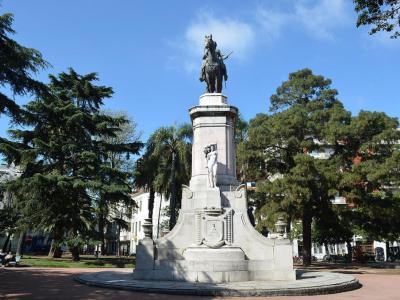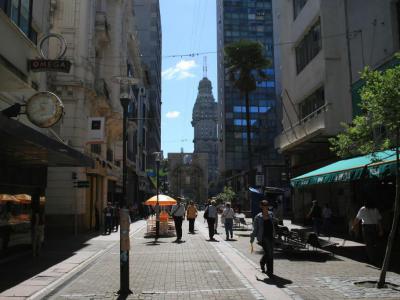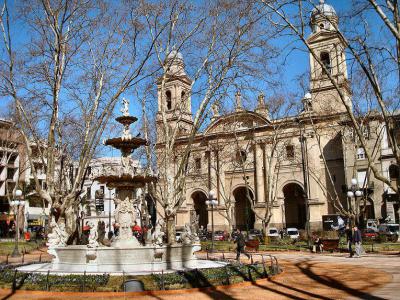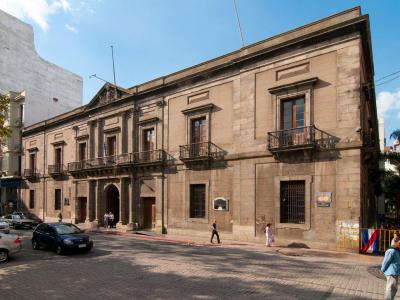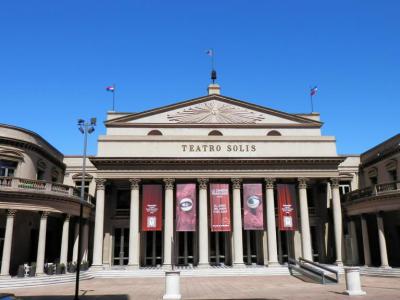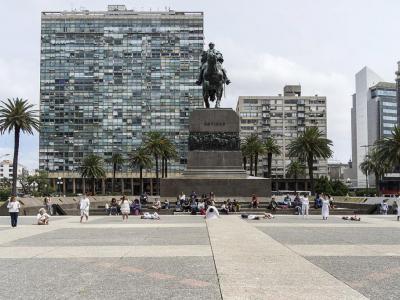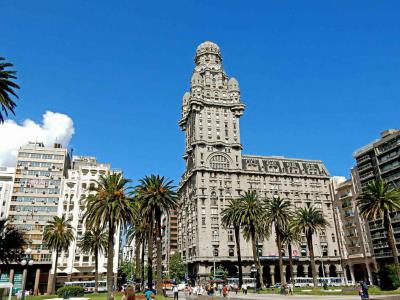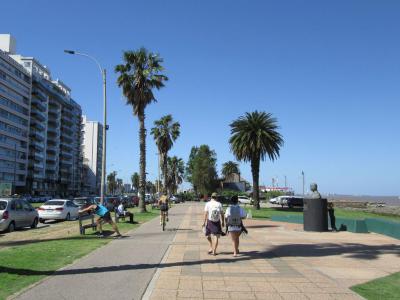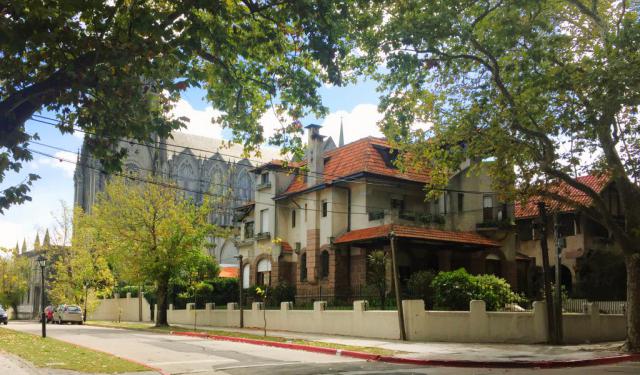
Montevideo Old Town Walking Tour (Self Guided), Montevideo
In 1683, the Portuguese founded a city called Colonia do Sacramento across the bay from Buenos Aires. Field marshal Manuel da Fonseca built a fort there he called Montevieu. In 1724, the Spanish governor of Buenos Aires, one-armed Bruno Mauricio de Zabala, forced the Portuguese out and changed the name of the city.
Bruno and the Spanish settlers called their new city "Saint Philip and Saint James of Montevideo." Montevideo was an important naval base of Spain. It became a walled, fortified city. The walls have long gone, leaving only a gateway called the "Citadel." The formerly fortified area is now the "Old City" of Montevideo.
The Old City has a wealth of colonial buildings and national monuments, as well as museums, galleries, restaurants, and nightclubs. It may be the "Old City," but it is as lively as it ever was.
Within the Old City, one will find the Solis Theatre, Uruguay's oldest theatre. The Artigas Monument is in the center of Independence Square. Jose Gervasio Artigas was a political leader, military general, and national hero of Uruguay. He fought in the Latin American wars of independence against the Spanish Empire. The monument crypt holds the remains of Artigas.
Exotic Salvo Palace amazes visitors with its wild eclecticism. The Constitution Square shares the Metropolitan Cathedral and the old Montevideo City Hall, which holds the city archives.
Plaza Zabala is home to Taranco Palace, the Museum of Decorative Arts. North of the plaza is the popular Port Market (Mercado del Puerto), a dining magnet. Have a stroll on the Rambla, a promenade that covers the entire coastline of Montevideo.
Montevideo was rated first in Latin America by the Mercer 2019 Quality of Life report. It has been described as a "vibrant, eclectic place with a rich cultural life." Eclecticism is a good word for the city. The vibrant cosmopolitan atmosphere embraces every traveler's dream in architecture, the arts, and within the population.
Bruno and the Spanish settlers called their new city "Saint Philip and Saint James of Montevideo." Montevideo was an important naval base of Spain. It became a walled, fortified city. The walls have long gone, leaving only a gateway called the "Citadel." The formerly fortified area is now the "Old City" of Montevideo.
The Old City has a wealth of colonial buildings and national monuments, as well as museums, galleries, restaurants, and nightclubs. It may be the "Old City," but it is as lively as it ever was.
Within the Old City, one will find the Solis Theatre, Uruguay's oldest theatre. The Artigas Monument is in the center of Independence Square. Jose Gervasio Artigas was a political leader, military general, and national hero of Uruguay. He fought in the Latin American wars of independence against the Spanish Empire. The monument crypt holds the remains of Artigas.
Exotic Salvo Palace amazes visitors with its wild eclecticism. The Constitution Square shares the Metropolitan Cathedral and the old Montevideo City Hall, which holds the city archives.
Plaza Zabala is home to Taranco Palace, the Museum of Decorative Arts. North of the plaza is the popular Port Market (Mercado del Puerto), a dining magnet. Have a stroll on the Rambla, a promenade that covers the entire coastline of Montevideo.
Montevideo was rated first in Latin America by the Mercer 2019 Quality of Life report. It has been described as a "vibrant, eclectic place with a rich cultural life." Eclecticism is a good word for the city. The vibrant cosmopolitan atmosphere embraces every traveler's dream in architecture, the arts, and within the population.
How it works: Download the app "GPSmyCity: Walks in 1K+ Cities" from Apple App Store or Google Play Store to your mobile phone or tablet. The app turns your mobile device into a personal tour guide and its built-in GPS navigation functions guide you from one tour stop to next. The app works offline, so no data plan is needed when traveling abroad.
Montevideo Old Town Walking Tour Map
Guide Name: Montevideo Old Town Walking Tour
Guide Location: Uruguay » Montevideo (See other walking tours in Montevideo)
Guide Type: Self-guided Walking Tour (Sightseeing)
# of Attractions: 11
Tour Duration: 2 Hour(s)
Travel Distance: 2.5 Km or 1.6 Miles
Author: jenny
Sight(s) Featured in This Guide:
Guide Location: Uruguay » Montevideo (See other walking tours in Montevideo)
Guide Type: Self-guided Walking Tour (Sightseeing)
# of Attractions: 11
Tour Duration: 2 Hour(s)
Travel Distance: 2.5 Km or 1.6 Miles
Author: jenny
Sight(s) Featured in This Guide:
- Port of Montevideo Public Terminal
- Mercado del Puerto (Port Market)
- Iglesia de San Francisco (San Francisco Church)
- Plaza Zabala (Zabala Square)
- Peatonal Sarandí (Sarandí Street)
- Catedral de Montevideo (Metropolitan Cathedral)
- Montevideo Cabildo (Old Montevideo City Hall)
- Teatro Solis (Solis Theatre)
- Plaza Independencia (Independence Square)
- Palacio Salvo (Salvo Palace)
- Rambla de Montevideo (Rambla of Montevideo)
1) Port of Montevideo Public Terminal
The Port of Montevideo Public Terminal stands as the principal maritime gateway to Uruguay, strategically located on the River Plate's central southern coast within the protective embrace of Montevideo Bay. This bustling port, with its significant historical and economic importance, serves as a vital hub for various maritime activities.
The port is ingeniously situated inside a bay, providing shelter and facilitating the efficient handling of diverse cargo and passenger vessels. Its infrastructure is divided into two primary sections, each dedicated to specific maritime functions. The eastern side of the bay is devoted to handling dry cargo, containers, and passenger vessels, while the northwestern side, known as La Teja, serves as the oil and gas terminal.
Visitors arriving at the Port of Montevideo are welcomed by a range of amenities within the entrance area. These include a post office, an Internet cafe (with associated charges), and captivating modern industrial sculptures that offer a unique backdrop for photo opportunities.
Cruise ships docking at the port enjoy close proximity to key attractions such as the market and the old town. One of the notable features appreciated by tourists is the convenience of shopping right across from the port entry gate. The surrounding area is teeming with an array of establishments, including souvenir shops, street vendors offering local crafts, jewelry stores, wine shops, restaurants, and stores specializing in artisanal products and clothing.
The port is ingeniously situated inside a bay, providing shelter and facilitating the efficient handling of diverse cargo and passenger vessels. Its infrastructure is divided into two primary sections, each dedicated to specific maritime functions. The eastern side of the bay is devoted to handling dry cargo, containers, and passenger vessels, while the northwestern side, known as La Teja, serves as the oil and gas terminal.
Visitors arriving at the Port of Montevideo are welcomed by a range of amenities within the entrance area. These include a post office, an Internet cafe (with associated charges), and captivating modern industrial sculptures that offer a unique backdrop for photo opportunities.
Cruise ships docking at the port enjoy close proximity to key attractions such as the market and the old town. One of the notable features appreciated by tourists is the convenience of shopping right across from the port entry gate. The surrounding area is teeming with an array of establishments, including souvenir shops, street vendors offering local crafts, jewelry stores, wine shops, restaurants, and stores specializing in artisanal products and clothing.
2) Mercado del Puerto (Port Market) (must see)
The Port Market of Montevideo is thought to be the ultimate gastronomic watering hole in the port of Montevideo. One thing to note, however. The market is not a market. It was once a real market, but that was a long time ago. Now it is an iron commercial palace, home to several restaurants having "the best meat in Uruguay."
The Port Market is located in the Old City section of town, right in front of the port. It was created in 1865 and built of iron, like many similar fashionable buildings in Europe at that time. Construction took nearly three years. The facility was inaugurated by the President of Uruguay, Lorenzo Batlle.
At present, the Market is a Mecca for carnivores. Uruguayans, it is said, love meat. They believe tourists feel the same way. Unforgettable dining experiences can be found in restaurants like La Chacra del Puerto, which features a Uruguayan meat grill. Then there is La Parrillada el Quarto, El Peregrino, and La Parrillada la Maestranza.
This unique market has a colonial appearance with a modern feel to it. The Port Market is open Monday to Sunday. Sundays are the busiest times.
The Port Market is located in the Old City section of town, right in front of the port. It was created in 1865 and built of iron, like many similar fashionable buildings in Europe at that time. Construction took nearly three years. The facility was inaugurated by the President of Uruguay, Lorenzo Batlle.
At present, the Market is a Mecca for carnivores. Uruguayans, it is said, love meat. They believe tourists feel the same way. Unforgettable dining experiences can be found in restaurants like La Chacra del Puerto, which features a Uruguayan meat grill. Then there is La Parrillada el Quarto, El Peregrino, and La Parrillada la Maestranza.
This unique market has a colonial appearance with a modern feel to it. The Port Market is open Monday to Sunday. Sundays are the busiest times.
3) Iglesia de San Francisco (San Francisco Church)
San Francisco Church is located in the Old City and should not be confused with the Church of St. Francis from the district of New Paris. The current church replaced the earlier building on the corner of Piedras Street and Zabala Square, built by the Jesuits in 1724. That church was transferred to the Franciscans in 1740.
The San Francisco Church has three naves under groin vault ceilings, a transept, and a semi-circular apse. The aisles are exceptionally high. There are four lower chapels on each side of the center nave housed between the buttresses. The tower has five bells in its carillon. Under the church is the crypt of the Lord of Patience.
This building is the epitome of what might be called Eclecticism. It joins several venerable styles within a single work. Greco-Roman classicism meets the Middle Ages in a composition featuring flying buttresses, a respectable rose window, Gothic arched windows grouped by twos and threes, and a Romanesque tower reaching skyward.
The temple we see today is an 1864 rebuild of the church of 1790. The rebuilding was under the direction of French-Uruguayan architect Victor Rabu. The central nave was inaugurated in 1881. In 1901 the tower was completed.
The crypt of the Lord of Patience is a place of quiet veneration in the Jesuit manner. The walls of the crypt are covered by the written prayers and messages of devotees. People baptized here have returned ever and ever again to the altar of the Lord of Patience.
The San Francisco Church has three naves under groin vault ceilings, a transept, and a semi-circular apse. The aisles are exceptionally high. There are four lower chapels on each side of the center nave housed between the buttresses. The tower has five bells in its carillon. Under the church is the crypt of the Lord of Patience.
This building is the epitome of what might be called Eclecticism. It joins several venerable styles within a single work. Greco-Roman classicism meets the Middle Ages in a composition featuring flying buttresses, a respectable rose window, Gothic arched windows grouped by twos and threes, and a Romanesque tower reaching skyward.
The temple we see today is an 1864 rebuild of the church of 1790. The rebuilding was under the direction of French-Uruguayan architect Victor Rabu. The central nave was inaugurated in 1881. In 1901 the tower was completed.
The crypt of the Lord of Patience is a place of quiet veneration in the Jesuit manner. The walls of the crypt are covered by the written prayers and messages of devotees. People baptized here have returned ever and ever again to the altar of the Lord of Patience.
4) Plaza Zabala (Zabala Square)
Bruno Mauricio de Zabala, Captain General of Spain, fought pirates and the Portuguese on the Rio de la Plata in the 18th century. To hold off these enemies, Bruno Mauricio de Zabala built a fortress on the coast called San Filipe y Santiago de Montevideo.
In 1878, Colonel Lorenzo La Torre, the dictator of Uruguay, decided to demolish the old fort of Zabala and replace it with a public square. The fortress was destroyed and remained a wasteland for 12 years. Finally, in 1890, the statue of Bruno Mauricio de Zabala on horseback, sculpted by Spanish artist Lorenzo Valera, was installed, and the Square was officially established.
Zabala Square has gardens designed by French landscape architect Eduardo Andre. Iron fences and gates enclose the gardens. The Square is surrounded by Ring Durango Street, named for the district of town where Zabala was born. On the south side of the square is the Taranco Palace, the Museum of Decorative Arts.
In 1878, Colonel Lorenzo La Torre, the dictator of Uruguay, decided to demolish the old fort of Zabala and replace it with a public square. The fortress was destroyed and remained a wasteland for 12 years. Finally, in 1890, the statue of Bruno Mauricio de Zabala on horseback, sculpted by Spanish artist Lorenzo Valera, was installed, and the Square was officially established.
Zabala Square has gardens designed by French landscape architect Eduardo Andre. Iron fences and gates enclose the gardens. The Square is surrounded by Ring Durango Street, named for the district of town where Zabala was born. On the south side of the square is the Taranco Palace, the Museum of Decorative Arts.
5) Peatonal Sarandí (Sarandí Street)
Sarandi Street is a major pedestrian street in the Old City of Montevideo. It is reputed to be the most popular tourist attraction in the city. It begins at the Ciudadela, the last remaining bit of the old citadel on Independence Square.
From the Ciudadela, Sarandi Street extends along Constitucion Square, also known as Matriz Square, and ends at the Rambla, the great promenade by the Rio de la Plata and the Atlantic Ocean. There are a lot of buildings of architectural importance, art galleries, shops, and small businesses on Sarandi Street.
The most notable buildings include the Pablo Ferrando Edifice, the Torres Garcia's Museum, the Hotel Plaza Fuerte, the Club Uruguay, the Montevideo Cabildo (housing the city's archives), and the Metropolitan Cathedral of Montevideo. The Sarandi Pier (Escollera Sarandi), the southern breakwater of the Port of Montevideo, is an extension of Sarandi Street.
From the Ciudadela, Sarandi Street extends along Constitucion Square, also known as Matriz Square, and ends at the Rambla, the great promenade by the Rio de la Plata and the Atlantic Ocean. There are a lot of buildings of architectural importance, art galleries, shops, and small businesses on Sarandi Street.
The most notable buildings include the Pablo Ferrando Edifice, the Torres Garcia's Museum, the Hotel Plaza Fuerte, the Club Uruguay, the Montevideo Cabildo (housing the city's archives), and the Metropolitan Cathedral of Montevideo. The Sarandi Pier (Escollera Sarandi), the southern breakwater of the Port of Montevideo, is an extension of Sarandi Street.
6) Catedral de Montevideo (Metropolitan Cathedral) (must see)
The Metropolitan Cathedral of Montevideo is the seat of the Catholic Church of Montevideo. It sits directly in front of the old Cabildo Montevideo, a colonial government house, by Constitution Square in the historic Old City. The site of the first brick church dates from 1740, in Spanish colonial times. In 1790, the foundation was laid for the construction of the current cathedral building.
The Cathedral was consecrated in 1804 and was dedicated to the Immaculate Conception and honors Saints Philip and James, the patron saints of the city. The architectural style of the building is Colonial Neoclassical, as designed by architect Tomas Toribio. The building's facade was formally completed in 1860.
Inside the Cathedral, there is one major altar, several side altars, memorials, tombs, ornate tiled floors, and graceful chandeliers. One of the side altars holds a statue of Our Lady of the Thirty-Three. She is celebrated as the Patroness of Uruguay and the Liberator of Uruguay.
No less than eight notable personalities are entombed within the Cathedral walls. They are various clergy, military, and political figures. The Cathedral is the inspiration for a musical work composed by the great Paraguayan classical guitarist and composer Agustin Pio Barrios. Considered to be his masterpiece, it is in three movements: Andante Religioso, Allegro Solemne, and Prelude.
The Cathedral holds artworks of great value by Uruguayan artists Jose Belloni, Juan Manuel Blanes and others. The church was consecrated when the country had not yet obtained its independence. Its Bicentenario was celebrated in 2004.
The Cathedral was consecrated in 1804 and was dedicated to the Immaculate Conception and honors Saints Philip and James, the patron saints of the city. The architectural style of the building is Colonial Neoclassical, as designed by architect Tomas Toribio. The building's facade was formally completed in 1860.
Inside the Cathedral, there is one major altar, several side altars, memorials, tombs, ornate tiled floors, and graceful chandeliers. One of the side altars holds a statue of Our Lady of the Thirty-Three. She is celebrated as the Patroness of Uruguay and the Liberator of Uruguay.
No less than eight notable personalities are entombed within the Cathedral walls. They are various clergy, military, and political figures. The Cathedral is the inspiration for a musical work composed by the great Paraguayan classical guitarist and composer Agustin Pio Barrios. Considered to be his masterpiece, it is in three movements: Andante Religioso, Allegro Solemne, and Prelude.
The Cathedral holds artworks of great value by Uruguayan artists Jose Belloni, Juan Manuel Blanes and others. The church was consecrated when the country had not yet obtained its independence. Its Bicentenario was celebrated in 2004.
7) Montevideo Cabildo (Old Montevideo City Hall)
The Montevideo City Hall is a historic building in the Old City of Uruguay's capital. Built on Constitution Square, opposite the Cathedral, this two-stored edifice was established to serve administrative and judicial functions.
Originally, the municipal council of Montevideo met in the house of Captain Pedro Groronardo, until in 1737 it was decided to build a designated headquarters. After a series of discussions, changes and various long-stops, caused by the continuous development of Montevideo at the end of the 18th century, the construction finally got underway in 1804.
Throughout the 19th-20th centuries, many important historic, political and social events took place at this heritage location. On July 18, 1830, in one of its rooms, the country's first Constitution was signed. Following that, it was the seat of the Uruguay's Parliament, whilst also serving as a prison.
In 1925, after the inauguration of the Legislative Palace, current home of the Uruguay's Parliament, the respective bodies left the building and the Ministry of Foreign Affairs moved in. In 1939, the City Hall saw intense diplomatic talks pertaining to the arrival of the German Navy ship Admiral Graf Spee that took part in the battle of Silver River (Río de la Plata). It was the first naval collision between Great Britain and Germany during World War II, and the only WWII episode in South America – occurred in Uruguayan territorial waters.
In the 1950s, the City Hall went back under the municipal management and became city history museum in September 1958. It is currently known as the Cabildo Historical Museum. It houses a vast collection of antiques, paintings, costumes, and historic documents. The entrance is free of charge.
Originally, the municipal council of Montevideo met in the house of Captain Pedro Groronardo, until in 1737 it was decided to build a designated headquarters. After a series of discussions, changes and various long-stops, caused by the continuous development of Montevideo at the end of the 18th century, the construction finally got underway in 1804.
Throughout the 19th-20th centuries, many important historic, political and social events took place at this heritage location. On July 18, 1830, in one of its rooms, the country's first Constitution was signed. Following that, it was the seat of the Uruguay's Parliament, whilst also serving as a prison.
In 1925, after the inauguration of the Legislative Palace, current home of the Uruguay's Parliament, the respective bodies left the building and the Ministry of Foreign Affairs moved in. In 1939, the City Hall saw intense diplomatic talks pertaining to the arrival of the German Navy ship Admiral Graf Spee that took part in the battle of Silver River (Río de la Plata). It was the first naval collision between Great Britain and Germany during World War II, and the only WWII episode in South America – occurred in Uruguayan territorial waters.
In the 1950s, the City Hall went back under the municipal management and became city history museum in September 1958. It is currently known as the Cabildo Historical Museum. It houses a vast collection of antiques, paintings, costumes, and historic documents. The entrance is free of charge.
8) Teatro Solis (Solis Theatre) (must see)
The Solis Theatre is Uruguay's oldest and most renowned theatre. Originally conceived as a watering hole where the elite of prosperous Montevideo could meet and greet, the Theatre opened its doors in 1856. It was designed by Italian architect Carlo Zucchi and is located in the historic neighborhood of Montevideo, next to Independence Square.
The Solis Theatre was named after Juan Diaz de Solis, a 16th-century explorer who was the first European to set foot in what is now Uruguay. The theatre was reconstructed in 1998. The rebuild included two columns designed by French architect Philippe Starck. Rehabilitation was completed in 2004 with acoustics by the French studio Avel Accoustique.
The main entrance of the Solis Theatre is at the intersection of Buenos Aires Street and Bartolomeo Mitre Street. The facade of the building is very much like that of the Teatro Carlo Felice in Genoa. It is a Romanesque architecture style with a Greek-style portico and columns. The elliptical interior also resembles the interiors of Italian opera houses.
The Solis Theatre is open evenings from Tuesday through Sunday. It is a venue for opera, ballet, theater, and classical music performances. Guided tours are available throughout the day.
The Solis Theatre was named after Juan Diaz de Solis, a 16th-century explorer who was the first European to set foot in what is now Uruguay. The theatre was reconstructed in 1998. The rebuild included two columns designed by French architect Philippe Starck. Rehabilitation was completed in 2004 with acoustics by the French studio Avel Accoustique.
The main entrance of the Solis Theatre is at the intersection of Buenos Aires Street and Bartolomeo Mitre Street. The facade of the building is very much like that of the Teatro Carlo Felice in Genoa. It is a Romanesque architecture style with a Greek-style portico and columns. The elliptical interior also resembles the interiors of Italian opera houses.
The Solis Theatre is open evenings from Tuesday through Sunday. It is a venue for opera, ballet, theater, and classical music performances. Guided tours are available throughout the day.
9) Plaza Independencia (Independence Square) (must see)
Jose Gervasio Artigas Arnal, the national hero of Uruguayan independence, was a fan of Thomas Paine, Jefferson, Rousseau, and other revolutionary writers of the 18th century. Although he is called the father of Uruguayan freedom, he died in exile. His remains were laid to rest in the Artigas Mausoleum on Independence Square in the center of Montevideo.
The Independence Square houses an equestrian statue of Artigas, created by Italian sculptor Angelo Zanelli. Stairs led from the monument to the underground mausoleum. The Square was designed in the 1830s by Italian architect Carlo Zucchi, who drew inspiration from Rivoli Street in Paris. The Independence Square was redesigned thirty years later by Swiss architect and sculptor Bernardo Poncini.
The Independence Square separates the Old City from downtown Montevideo. The gateway of Ciudadela and the Montevideo Twin Towers are on one side of the Square, and the 18th of July Avenue is on the other. The Solis Theatre, the 19th century Estevez Palace, and the Executive Tower are nearby. The landmark Salvo Palace is also nearby.
The Artigas monument dominates the center of Independence Square. Large green areas cover each of the four rounded corners of the Square. The place is surrounded by a broad and heavily trafficked motorway.
In May and June of 2009, Independence Square hosted the 17th exhibition of the United Buddy Bears project. The Buddy Bears are life-sized fiberglass bear sculptures created by Austrian sculptor Roman Strobl. The outstretched arms of the standing Buddy Bear symbolize friendliness and optimism. The Buddy Bears have appeared in Paris, Rio de Janeiro, Cairo, Shanghai, and St. Gallen, Switzerland.
The Independence Square houses an equestrian statue of Artigas, created by Italian sculptor Angelo Zanelli. Stairs led from the monument to the underground mausoleum. The Square was designed in the 1830s by Italian architect Carlo Zucchi, who drew inspiration from Rivoli Street in Paris. The Independence Square was redesigned thirty years later by Swiss architect and sculptor Bernardo Poncini.
The Independence Square separates the Old City from downtown Montevideo. The gateway of Ciudadela and the Montevideo Twin Towers are on one side of the Square, and the 18th of July Avenue is on the other. The Solis Theatre, the 19th century Estevez Palace, and the Executive Tower are nearby. The landmark Salvo Palace is also nearby.
The Artigas monument dominates the center of Independence Square. Large green areas cover each of the four rounded corners of the Square. The place is surrounded by a broad and heavily trafficked motorway.
In May and June of 2009, Independence Square hosted the 17th exhibition of the United Buddy Bears project. The Buddy Bears are life-sized fiberglass bear sculptures created by Austrian sculptor Roman Strobl. The outstretched arms of the standing Buddy Bear symbolize friendliness and optimism. The Buddy Bears have appeared in Paris, Rio de Janeiro, Cairo, Shanghai, and St. Gallen, Switzerland.
10) Palacio Salvo (Salvo Palace)
The Salvo Palace is one of the most important buildings for its cultural, historical, and architectural interest in Montevideo. It is located on the corner of Independence Square and the Avenue on the 18th of July. The building was designed by Italian architect Mario Palanti, and inaugurated in 1928. At the time, it was the tallest building in Latin America, 95 meters high, and continues to be one of the tallest buildings in the city.
Palanti's design inspiration was drawn from Dante Alighieri's Divine Comedy. Mario Palanti also used this concept in the design of his Barolo Palace in Buenas Aires, Argentina. Salvo Palace, like Barolo Palace, is divided into three so-called sections: the lower floors- "Hell", the middle floors-"Purgatory", and the top floors-"Heaven."
The architectural style of the building is a kind of eclectic Art Deco combined with echos of Renaissance and Gothic elements and Neoclassical touches. It has become the symbol of the city, recalling the period of prosperity in the early years of the 20th century.
At present, the building houses separate apartments, offices, coffee and gift shops, and the Tango Museum of Montevideo. The Tango Museum is open to the public and exhibits the history of the famous tango "La Cumparsita" and the Uruguayan Tango.
Palanti's design inspiration was drawn from Dante Alighieri's Divine Comedy. Mario Palanti also used this concept in the design of his Barolo Palace in Buenas Aires, Argentina. Salvo Palace, like Barolo Palace, is divided into three so-called sections: the lower floors- "Hell", the middle floors-"Purgatory", and the top floors-"Heaven."
The architectural style of the building is a kind of eclectic Art Deco combined with echos of Renaissance and Gothic elements and Neoclassical touches. It has become the symbol of the city, recalling the period of prosperity in the early years of the 20th century.
At present, the building houses separate apartments, offices, coffee and gift shops, and the Tango Museum of Montevideo. The Tango Museum is open to the public and exhibits the history of the famous tango "La Cumparsita" and the Uruguayan Tango.
11) Rambla de Montevideo (Rambla of Montevideo) (must see)
Formerly known as "Rambla Naciones Unidas" [United Nations Avenue], Rambla de Montevideo [Montevideo Avenue] is a promenade in the capital of Uruguay that runs along the coastline of Río de la Plata in the South of the Bay of Montevideo. At a length of 24 uninterrupted kilometers (nearly 15 miles), this is the longest continuous sidewalk in the world. Bordered by a number of beaches, most notably the ones like Ramírez (Parque Rodó), Pocitos, Buceo, Malvín and Carrasco, La Rambla is a magnet for those keen on outdoor activities.
Numerous geographical features give it variety and interest, such as Punta de las Carretas (aka Punta Brava, a Montevideo neighborhood) and Isla de las Gaviotas (a small islet in the Río de la Plata). On weekends, the area attracts thousands of people of all ages, who come in search of walking, jogging, sunbathing, having a bit of fresh air or simply drinking mate with friends. In several designated areas, especially at Rambla Sur, there are good spots for sport fishing.
There are yacht moorings at Punta Carretas and Puerto del Buceo. Fans of football, cycling, kite-flying and skateboarding will find it an ideal place for recreation – no doubt. In addition, there are ample opportunities for bird-watching, too, given the variety of coastal species inhabiting the area. The avenue is secured by the Tourism Police Unit during the summer to keep it safe for tourists.
Apart from offering great environment for recreation, still, the Avenue also constitutes an important vehicular traffic route. Construction activities on the side of the beach at La Rambla is strictly regulated so as not to ruin the view.
Being an integral part of the Montevidean identity, La Rambla has been declared a Historical Monument. In 2010 it was proposed to be listed as a UNESCO World Heritage site.
Numerous geographical features give it variety and interest, such as Punta de las Carretas (aka Punta Brava, a Montevideo neighborhood) and Isla de las Gaviotas (a small islet in the Río de la Plata). On weekends, the area attracts thousands of people of all ages, who come in search of walking, jogging, sunbathing, having a bit of fresh air or simply drinking mate with friends. In several designated areas, especially at Rambla Sur, there are good spots for sport fishing.
There are yacht moorings at Punta Carretas and Puerto del Buceo. Fans of football, cycling, kite-flying and skateboarding will find it an ideal place for recreation – no doubt. In addition, there are ample opportunities for bird-watching, too, given the variety of coastal species inhabiting the area. The avenue is secured by the Tourism Police Unit during the summer to keep it safe for tourists.
Apart from offering great environment for recreation, still, the Avenue also constitutes an important vehicular traffic route. Construction activities on the side of the beach at La Rambla is strictly regulated so as not to ruin the view.
Being an integral part of the Montevidean identity, La Rambla has been declared a Historical Monument. In 2010 it was proposed to be listed as a UNESCO World Heritage site.
Walking Tours in Montevideo, Uruguay
Create Your Own Walk in Montevideo
Creating your own self-guided walk in Montevideo is easy and fun. Choose the city attractions that you want to see and a walk route map will be created just for you. You can even set your hotel as the start point of the walk.
Prado District Walking Tour
A quiet, upscale barrio El Prado, in the north of Montevideo, is famous primarily for the sprawling park of the same name. Indeed, the city’s main green space, Parque del Prado is a major public venue made up of grassy fields, with the Arroyo Miguelete (Miguelete Creek) running through it, for which the neighborhood has been dubbed "the lung of the city".
Apart from the park,... view more
Tour Duration: 2 Hour(s)
Travel Distance: 3.6 Km or 2.2 Miles
Apart from the park,... view more
Tour Duration: 2 Hour(s)
Travel Distance: 3.6 Km or 2.2 Miles
The Most Popular Cities
/ view all
